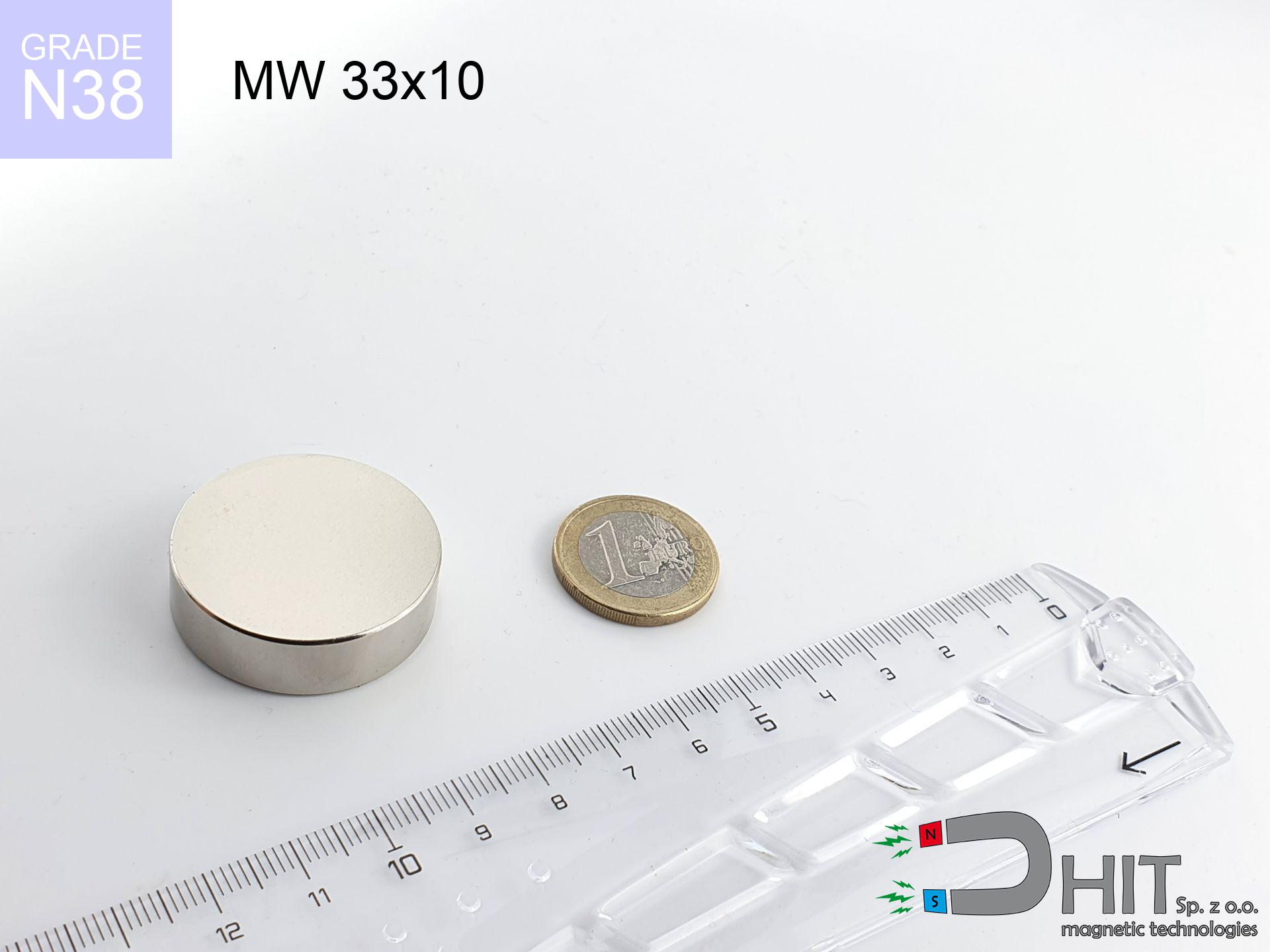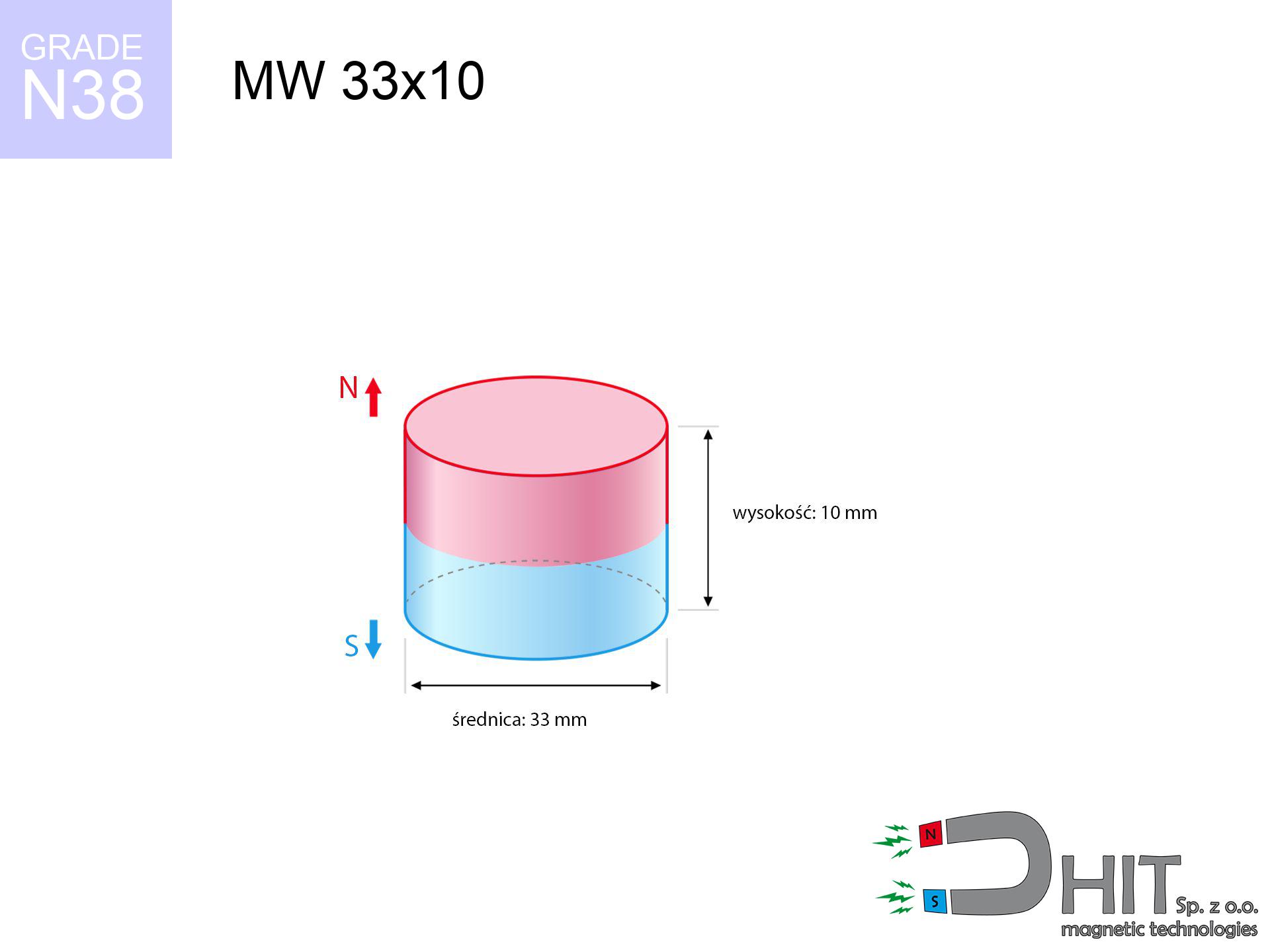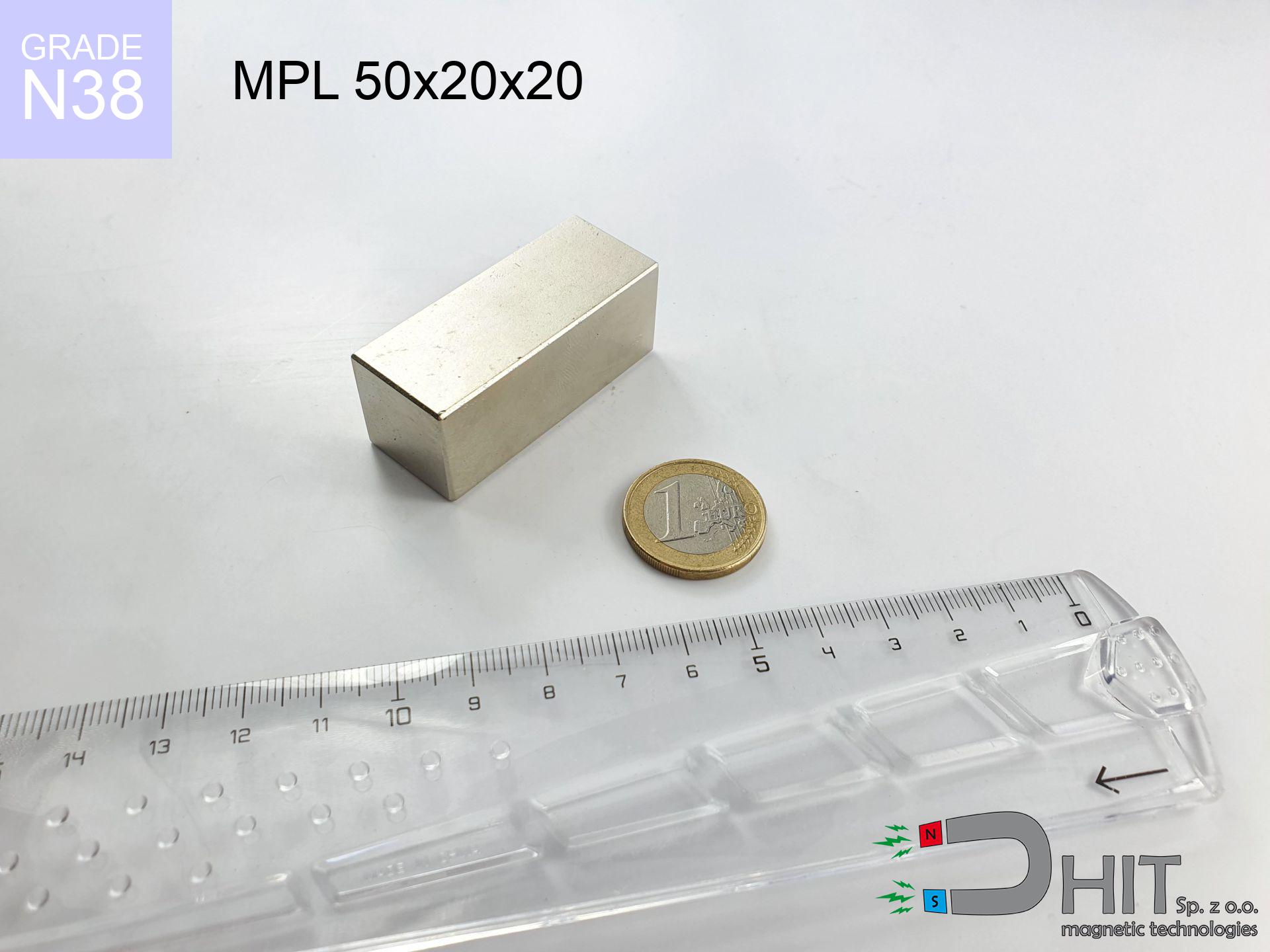MW 33x10 / N38 - cylindrical magnet
cylindrical magnet
Catalog no 010057
GTIN: 5906301810568
Diameter Ø [±0,1 mm]
33 mm
Height [±0,1 mm]
10 mm
Weight
64.15 g
Magnetization Direction
↑ axial
Load capacity
18.25 kg / 178.97 N
Magnetic Induction
321.26 mT
Coating
[NiCuNi] nickel
19.00 ZŁ with VAT / pcs + price for transport
15.45 ZŁ net + 23% VAT / pcs
bulk discounts:
Need more?Want to negotiate the price?
Call us +48 22 499 98 98 or write via form on the contact page. Test the magnet's power with our power calculator.
Orders placed by 14:00 are shipped the same day.
MW 33x10 / N38 - cylindrical magnet
Magnetic properties of material N38
Physical properties of NdFeB
Shopping tips
Moreover, although neodymium is a component of the strongest magnets, they are susceptible to corrosion in humid environments. For this reason, they are coated with a thin layer of gold-nickel to protect them from corrosion. Interestingly that NdFeB neodymium magnets are about 13% lighter than SmCo magnets and, despite their power, are brittle, which requires care during their handling. For this reason, any mechanical processing should be done before they are magnetized.
In terms of safety, there are many recommendations regarding the use of these magnets. They should not be used in acidic, basic, organic environments or where solvents are present, as well as in water or oil. Furthermore, they can damage data on magnetic cards and hard drives, although data deletion using a neodymium magnet is not always certain.
In terms of properties in different environments, neodymium magnets are sensitive to corrosion, especially in humid conditions. Therefore, they are often coated with coatings, such as nickel, to preserve them from external factors and extend their lifespan. High temperatures exceeding 130°C can cause a loss of their magnetic properties, although there are particular types of neodymium magnets that can tolerate temperatures up to 230°C.
As for risks, it is important to avoid using neodymium magnets in acidic environments, basic environments, organic or solvent environments, unless they are adequately insulated. Additionally, their use is not recommended in wet conditions, oil, or in an environment containing hydrogen, as they may lose their magnetic properties.
Advantages and disadvantages of neodymium magnets NdFeB.
In addition to immense power, neodymium magnets have the following advantages:
- They do not lose power over time. After about 10 years, their power decreases by only ~1% (theoretically),
- They protect against demagnetization caused by external magnetic sources extremely well,
- In other words, thanks to the shiny coating of nickel, gold, or silver, the element acquires an aesthetic appearance,
- They exhibit extremely high magnetic induction on the surface of the magnet,
- By using an appropriate combination of materials, they can achieve significant thermal resistance, allowing them to operate at temperatures up to 230°C and above...
- Due to the option of accurate forming and adaptation to individual needs – neodymium magnets can be produced in a wide range of shapes and sizes, which amplifies their universality in usage.
- Significant importance in advanced technologically fields – are used in computer drives, electric drive mechanisms, medical equipment or other advanced devices.
Disadvantages of neodymium magnets:
- They are prone to breaking as they are fragile when subjected to a powerful impact. If the magnets are exposed to impacts, we recommend using magnets in a protective case. The steel housing in the form of a holder protects the magnet from impacts and simultaneously increases its overall strength,
- They lose power at high temperatures. Most neodymium magnets experience permanent loss of strength when heated above 80°C (depending on the form and height). However, we also offer special magnets with high temperature resistance, up to 230°C,
- Magnets exposed to a humid environment can corrode. Therefore, when using them outdoors, we suggest using waterproof magnets made of rubber, plastic, or other moisture-resistant materials,
- The use of a cover or a magnetic holder is recommended due to the limited possibilities of manufacturing threads or complex shapes in the magnet
- Health risk to health from tiny fragments of magnets can be dangerous, when accidentally ingested, which is crucial in the aspect of protecting young children. Additionally, small elements of these products are able to hinder the diagnostic process after entering the body.
Handle Neodymium Magnets Carefully
Neodymium magnets are among the strongest magnets on Earth. The surprising force they generate between each other can shock you.
Make sure to review all the information we have provided. This will help you avoid harm to your body and damage to the magnets.
Neodymium magnets should not be near people with pacemakers.
In the case of neodymium magnets, there is a strong magnetic field. As a result, it interferes with the operation of a heart pacemaker. Even if the magnetic field does not affect the device, it can damage its components or deactivate the entire device.
Avoid bringing neodymium magnets close to a phone or GPS.
Magnetic fields can interfere with compasses and magnetometers used in aviation and maritime navigation, as well as internal compasses of smartphones and GPS devices. There are neodymium magnets in every smartphone, for example, in the microphone and speakers.
Neodymium magnets can become demagnetized at high temperatures.
Under specific conditions, Neodymium magnets may experience demagnetization when subjected to high temperatures.
Make sure not to bring neodymium magnets close to the TV, wallet, and computer HDD.
Strong magnetic fields emitted by neodymium magnets can destroy magnetic storage media such as floppy disks, credit cards, magnetic ID cards, cassette tapes, video tapes, or other devices. They can also damage televisions, VCRs, computer monitors, and CRT displays. You should especially avoid placing neodymium magnets near electronic devices.
The magnet coating is made of nickel, so be cautious if you have an allergy.
Studies show a small percentage of people have allergies to certain metals, including nickel. An allergic reaction often manifests as skin redness and rash. If you have a nickel allergy, try wearing gloves or avoid direct contact with nickel-plated neodymium magnets.
Dust and powder from neodymium magnets are flammable.
Do not attempt to drill into neodymium magnets. Mechanical processing is also not recommended. Once crushed into fine powder or dust, this material becomes highly flammable.
Neodymium magnets are primarily characterized by their significant internal force. They attract to each other, and any object that comes in their way will be affected.
In the case of holding a finger in the path of a neodymium magnet, in such a case, a cut or a fracture may occur.
Magnets should not be treated as toys. Therefore, it is not recommended for children to have access to them.
Neodymium magnets are not toys. You cannot allow them to become toys for children. In the case of small magnets, they can be swallowed and cause choking. In such cases, the only solution is to undergo surgery to remove the magnets, and otherwise, it can even lead to death.
Magnets made of neodymium are extremely delicate, they easily crack and can become damaged.
Neodymium magnets are extremely fragile, and by joining them in an uncontrolled manner, they will crack. Neodymium magnetic are made of metal and coated with a shiny nickel, but they are not as durable as steel. At the moment of collision between the magnets, sharp metal fragments can be dispersed in different directions.
Pay attention!
So you are aware of why neodymium magnets are so dangerous, read the article titled How dangerous are very powerful neodymium magnets?.




![UMGW 25x17x8 [M5] GW / N38 - magnetic holder internal thread UMGW 25x17x8 [M5] GW / N38 - magnetic holder internal thread](https://cdn3.dhit.pl/graphics/products/um-25x17x8-m5-gw-dob.jpg)

![UMGGW 88x8.5 [M6] GW / N38 - magnetic holder rubber internal thread UMGGW 88x8.5 [M6] GW / N38 - magnetic holder rubber internal thread](https://cdn3.dhit.pl/graphics/products/umg-88x8.5-m8-gw-let.jpg)


